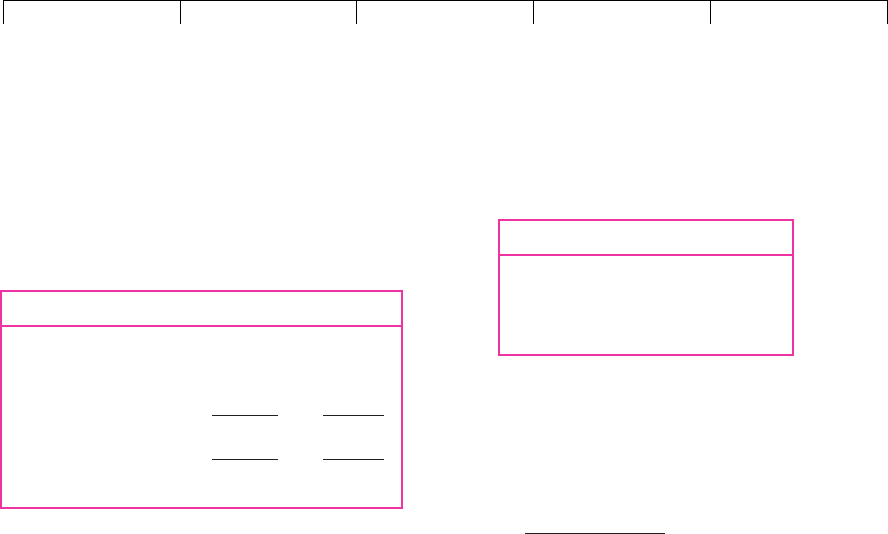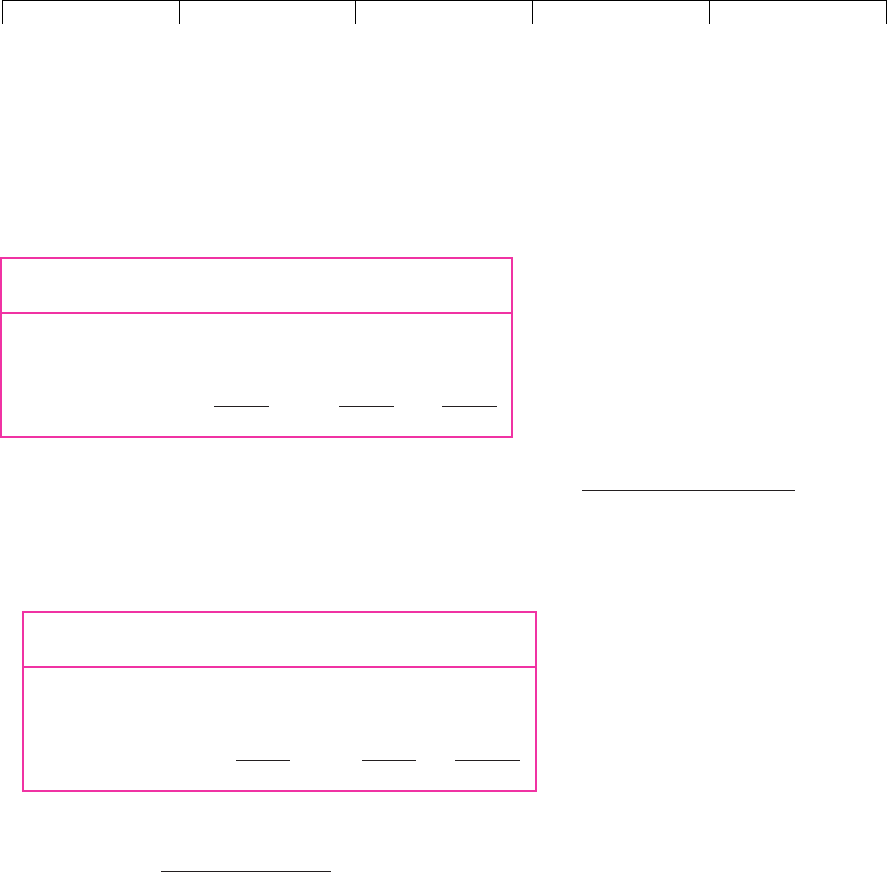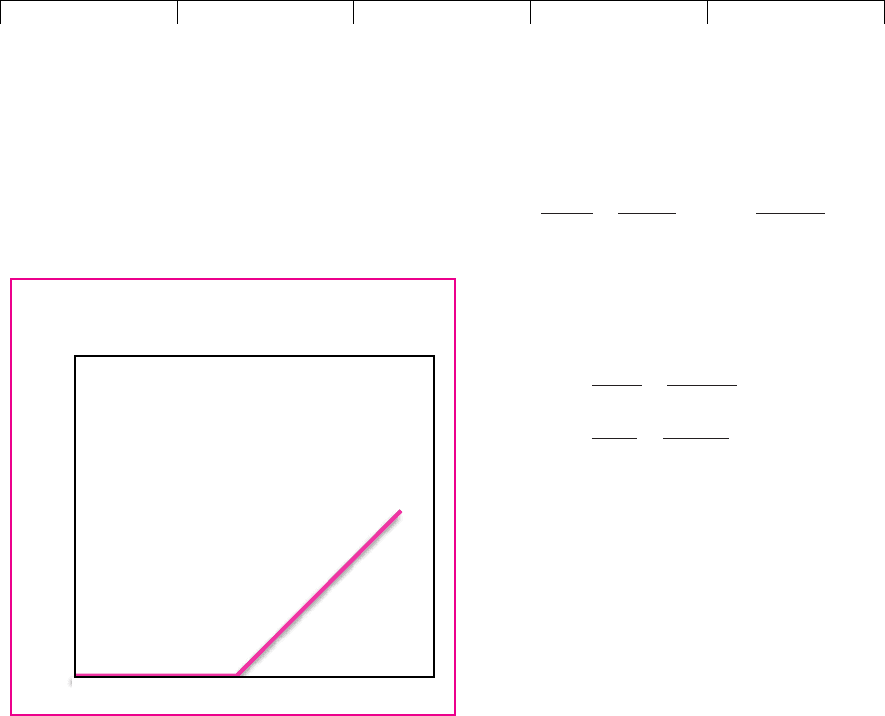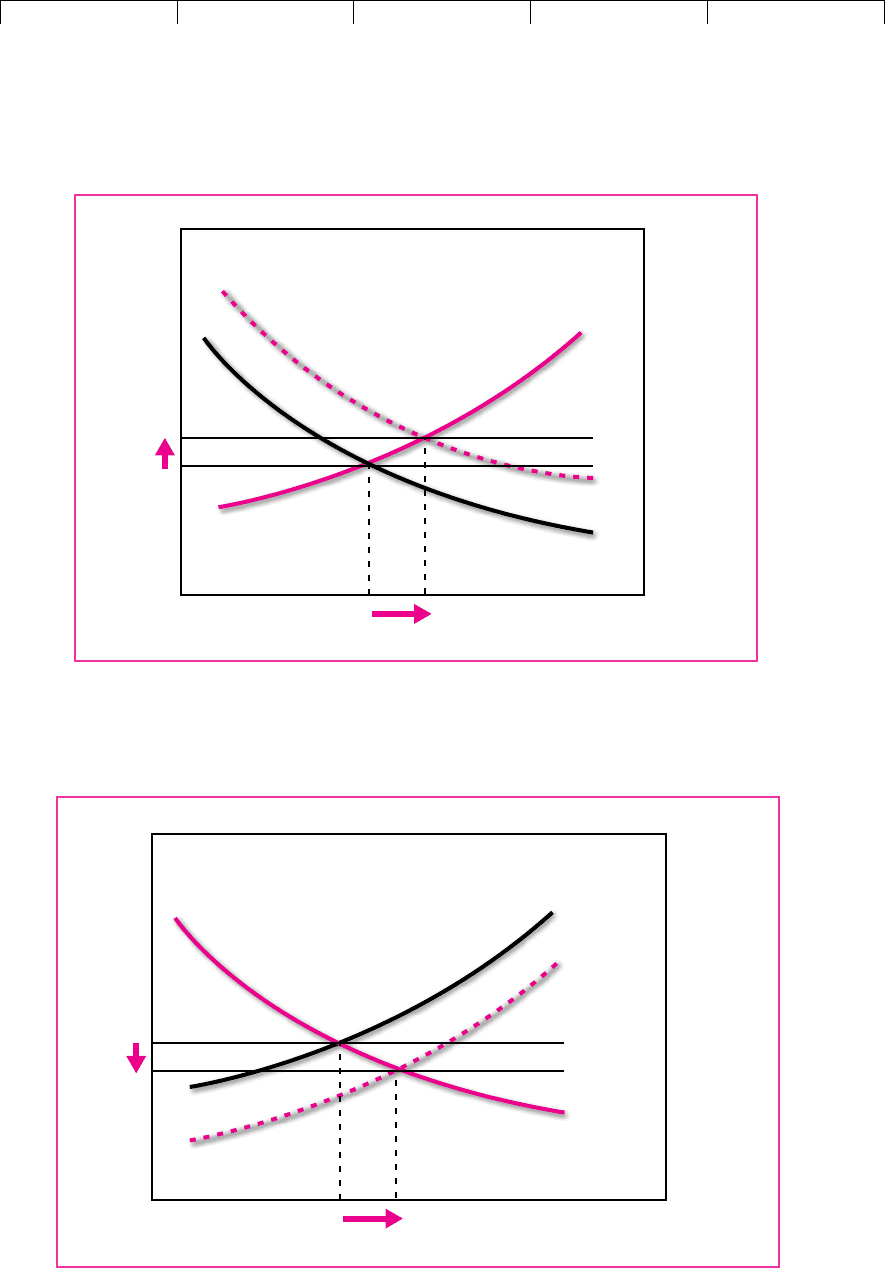Brealey, Myers. Principles of Corporate Finance. 7th edition
Подождите немного. Документ загружается.


Brealey−Meyers:
Principles of Corporate
Finance, Seventh Edition
Back Matter Appendix B Answers to
Quizzes
© The McGraw−Hill
Companies, 2003
c. Project interactions may be ignored. Some op-
portunities, such as the closing or sale of a divi-
sion, will not be considered. Strategic invest-
ments may be missed.
d. Creates a bias in favor of quick payback projects
and against long-lived projects that may have
large NPVs.
3. A change in the hurdle rate is offset by more or less
optimistic forecasts by project sponsors. There’s no
way out: the financial manager can’t avoid careful
assessment of cash-flow forecasts.
4. Agency costs: value lost when managers do not act
to maximize value. This includes costs of monitor-
ing and control.
Private benefits: perks or other advantages enjoyed
by managers.
Empire building: investing for size, not NPV.
Free-rider problem: when one shareholder, or group
of shareholders, acts to monitor and control man-
agement, all shareholders benefit.
Entrenching investment: managers choose or design
investment projects which increase the managers’
value to the firm.
Delegated monitoring: monitoring on behalf of
principals. For example, the board of directors
monitors management performance on behalf of
stockholders.
5. Monitoring is costly and encounters diminishing
returns. Also, completely effective monitoring
would require perfect information.
6. (a) Dollar amount; (b) EVA Income earned
(cost of capital investment); (c) They are essen-
tially the same; (d) EVA makes the cost of capital
visible to managers. Compensation based on EVA
encourages them to dispose of unnecessary assets
and to forego investment unless it earns more than
the cost of capital; (e) Yes.
7. Return on investment 1.6/20 .08 or 8%. EVA
1.6 (.115 20) $.7 million. EVA is negative.
8. (a) False: profits may be depressed temporarily, but
in a steady state, writing off R&D can increase the
book rate of return; (b) true—because asset value is
understated, the ratio of income to assets is biased
upward.
9. Cash flow, economic, less, greater.
APPENDIX B Answers to Quizzes 1023
10.
Year 1 Year 2 Year 3
Cash flow 0 78.55 78.55
PV at start of year 100.00 120.00 65.45
PV at end of year 120.00 65.45 0
Change in value during year 20.00 54.55 65.45
Expected economic income 20.00 24.00 13.10
Chapter 13
1. c
2. Weak, semistrong, strong, strong, weak.
3. (a) False; (b) false; (c) true; (d) false; (e) false; (f) true.
4. (a) Decline to $200; (b) less; (c) A slight abnormal
fall (the split is likely to have led investors to expect
an above-average rise in dividends).
5. (a) False; (b) true; (c) false; (d) true; (e) false; (f) true
(a small change in price in the absence of new infor-
mation causes a large increase in demand).
6. .
7. (a) True; (b) false; (c) true; (d) true.
8. Decrease. The stock price already reflects an ex-
pected 25% increase. The 20% increase conveys bad
news relative to expectations.
9. a. An investor should not buy or sell shares based
on apparent trends or cycles in returns.
b. A CFO should not speculate on changes in interest
rates or foreign exchange rates. There is no reason
to think that the CFO has superior information.
6 1.2 1.45 521.05%
c. A financial manager evaluating the creditwor-
thiness of a large customer could check the cus-
tomer’s stock price and the yield on its debt. A
falling stock price or a high yield could indicate
trouble ahead.
d. Don’t assume that accounting choices which in-
crease or decrease earnings will have any effect
on stock price.
e. The company should not seek diversification
just to reduce risk. Investors can diversify on
their own.
f. Stock issues do not depress price if investors be-
lieve the issuer has no private information.
Chapter 14
1. Internally generated cash 77
Financial deficit 23
Net share issues 14
Debt issues 38
2. (a) False; (b) true; (c) true; (d) false.

Brealey−Meyers:
Principles of Corporate
Finance, Seventh Edition
Back Matter Appendix B Answers to
Quizzes
© The McGraw−Hill
Companies, 2003
3. (a) ; (b) 78,000 shares;
(c) 2,000 shares are held as Treasury stock; (d) 20,000
shares.
40,000/.50 80,000 shares
7. a. Net proceeds of public issue 10,000,000
150,000 80,000 $9,770,000; net proceeds of
private placement $9,970,000.
b. PV of extra interest on private placement
i.e., extra cost of higher interest on private place-
ment more than outweighs saving in issue costs.
N.b. We ignore taxes.
c. Private placement debt can be custom-tailored
and the terms more easily renegotiated.
8. An underwriter building a book solicits bids from
investors, but the bids are not binding and are used
only as a guide to set the issue price.
9. (a) Number of new shares, 50,000; (b) Amount of
new investment, $500,000; (c) Total value of com-
pany after issue, $4,500,000; (d) Total number of
shares after issue, 150,000; (e) Stock price after issue,
$4,500,000/150,000 $30; (f) The opportunity to
buy one share is worth $20.
Chapter 16
1. (a) A1, B5; A2, B4; A3, B3; A4, B1; A5, B2. (b) March
7 ex-dividend date; (c) (.34 4)/80.20 .017, or
1.7%; (d) (.34 4)/3.20 .43 or 43%; (e) The price
would fall to .
2. (a) .26; (b) .36.
3. (a) False; (b) true.
4. a. False. The dividend depends on past dividends
and current and forecasted earnings.
b. True. This target does reflect growth opportuni-
ties and capital expenditure requirements.
c. False. Dividends are adjusted gradually to a tar-
get. The target is based on current or forecasted
earnings multiplied by the target payout ratio.
d. True. Dividend changes convey information to
investors.
e. False. Dividends are “smoothed.” Managers
rarely increase regular dividends temporarily.
They may pay a special dividend, however.
f. False. Dividends are rarely cut when repur-
chases are being made.
80.20/1.1 $
ˇ 72.91
a
10
t1
.005 10,000,000
1.085
t
$ˇ 328,000,
1024 APPENDIX B Answers to Quizzes
(e) (f)
Common stock $ 45,000 $40,000
Additional paid-in 25,000 10,000
capital
Retained earnings 30,000 30,000
Common equity 100,000 80,000
Treasury stock 5,000 30,000
Net common $ 95,000 $50,000
equity
4. (a) 80 votes; (b) .
5. Similarities with debt: (a) Fixed income; (b) preferred
stockholders have limited voting rights.
Similarities with equity: (a) Dividend is within
discretion of directors; (b) no final repayment date;
(c) dividend is not an allowable deduction from
taxable profits.
6. (a) subordinated; (b) floating rate; (c) convertible;
(d) warrant; (e) common stock; preferred stock.
7. (a) False; (b) true; (c) false.
8. A debt issue sold in international markets.
9. Support of the payment mechanism, facilitating
borrowing and lending, pooling risk.
Chapter 15
1. (a) Further sale of an already publicly traded stock;
(b) U.S. bond issue by foreign corporation; (c) Bond
issue by industrial company; (d) Bond issue by
large industrial company.
2. (a) B; (b) A; (c) D; (d) C.
3. a. Financing of startup companies.
b. First sale of a security to public investors.
c. Trading of a security after it is issued.
d. Description of a security offering filed with
the SEC.
e. Winning bidders for a new issue tend to
overpay.
f. One or a few underwriters buy an entire issue.
4. (a) A large issue; (b) a bond issue; (c) subsequent is-
sue of stock; (d) a small private placement of bonds.
5. (a) False; (b) true; (c) true.
6. (a) 135,000 shares; (b) primary: 500,000 shares; sec-
ondary: 400,000 shares; (c) $25 or 31%, which is
higher than the average underpricing.
10 80 800 votes
Millions
Underwriting cost $ 5.04
Administrative cost .82
Underpricing 22.5
Total $28.36
Note: Calculation ignores cost of shares sold
under greenshoe option.
(d)

Brealey−Meyers:
Principles of Corporate
Finance, Seventh Edition
Back Matter Appendix B Answers to
Quizzes
© The McGraw−Hill
Companies, 2003
5. a. Reinvest in the stock. If
the ex-dividend price is , this
should involve the purchase of 500/147.50, or
about 3.4 shares.
b. Sell shares worth . If the ex-
dividend price is , this should involve
the sale of 3,000/195, or about 15 shares.
6. (a) Raise an additional £2 million by an issue of
shares; (b) Reduce cash by $10 million or issue new
shares for $10 million.
7. a. Company value is unchanged at
. Share price stays at $140.
b. The discount rate r (DIV
1
/P
0
) g (20/140)
.05 .193. The price at which shares are re-
purchased in year 1 is 140 (1 r) 140
1.193 $167. Therefore the firm repurchases
50,000/167 299 shares. Total dividend pay-
ments in year 1 fall to 5,000 10 $50,000,
which is equivalent to 50,000/(5000 299)
$
ˇ 700,000
5,000 140
$ˇ 200 $ˇ 5
1,000 $
ˇ 3 $ˇ 3,000
$
ˇ 150 $ˇ 2.50
1,000 $
ˇ .50 $ˇ 500 $10.64 a share. Similarly, in year 2 the firm re-
purchases 281 shares at $186.52 and the divi-
dend per share increases by 11.7% to $11.88. In
each subsequent year total dividends increase
by 5%, the number of shares declines by 6% and
therefore dividends per share increase by 11.7%.
The constant growth model gives PV share
10.64/(.193 .117) $140.
8. a. $127.25.
b. Nothing; the stock price will stay at $130.
846,154 shares will be repurchased.
c. The with-dividend price stays at $130. Ex-
dividend it drops to $124.50; 883,534 shares will
be issued.
9. Current tax law: (a) shouldn’t care; (b) prefers Lo;
(c) prefers Hi; (d) shouldn’t care; (e) shouldn’t care.
Same rate of tax: An individual now shouldn’t care.
Otherwise preferences do not change.
APPENDIX B Answers to Quizzes 1025
Market Value
Common stock $16,000,000
(8 million shares at $2)
Short-term loans $ 2,000,000
Chapter 17
1. (a) .10P; (b) Buy 10% of B’s debt 10% of B’s eq-
uity; (c) .10(P 100); (d) Borrow an amount equal
to 10% of B’s debt and buy 10% of A’s equity.
2. Note the market value of Copperhead is far in ex-
cess of its book value:
.13 20/60(.13 .08) .147. If stockholders
pass on more of the firm’s risk to debtholders, ex-
pected return on equity will be less than 14.7%.
4. a. (i) 
A
.
(ii) ; (iii) .
b. (i) .10.
(ii)
.
(iii) ; (iv) .
c. (i) 50%; (ii) 6.7 (i.e., the P/E ratio falls to offset
the increase in EPS).
r
A
.10r
D
.05
r
E
.15
.10 1.5 .052 1.5 r
E
2
r
A
a
D
D E
r
D
b a
E
D E
r
E
b

A
1.0
D
0

E
2.0
1.0 1.5 02 1.5 
E
2
a
D
D E

D
b a
E
D E

E
b
5. a.
Operating income ($) 500 1,000 1,500 2,000
Interest ($) 250 250 250 250
Equity earnings ($) 250 750 1,250 1,750
Earnings per share .33 1.00 1.67 2.33
Return on shares (%) 3.3 10 16.7 23.3
Ms. Kraft owns .625% of the firm, which proposes
to increase common stock to $17 million and cut
short-term debt. Ms. Kraft can offset this by (a) bor-
rowing .00625 1,000,000 $6,250, and (b) buying
that much more Copperhead stock.
3. Expected return on assets is r
A
.08 30/80 .16
50/80 .13. The new return on equity will be r
E
b.
. 
E
1.07
.8 1.25 02 1.75 
E
2

A
a
D
D E

D
b a
E
D E

E
b
6. a. True, so long as the market value of “old” debt
does not change.
b. False. MM’s Proposition I says only that overall
firm value does not depend on
capital structure.
1V D E2

Brealey−Meyers:
Principles of Corporate
Finance, Seventh Edition
Back Matter Appendix B Answers to
Quizzes
© The McGraw−Hill
Companies, 2003
c. False. Borrowing increases equity risk even if
debt is default-risk-free.
d. False. Limited liability affects the relative values
of debt and equity, not their sum.
e. True. Limited liability protects shareholders if
the firm defaults.
f. True—but the required rate of return on equity
and the firm’s assets are the same only if the firm
holds risk-free assets. In this case , and all
equal the risk-free rate of interest.
g. False. The shareholders could make the same
debt issue on their own account.
h. True. To put it more precisely, it assumes that the
expected rate of return to equity goes up, but
stockholders’ required rate of return goes up pro-
portionately. Therefore, stock price is unchanged.
i. False. The formula
does not require .
j. False. The clientele has to be willing to pay extra
for the debt, which it will not do if plenty of cor-
porate debt issues are already available.
7. See Figure 17.5.
8. (a) ; (b) (unchanged),
; (c) 18.3%.
9. (a) 10%; (b) 13.3%.
10. (a) Not affected; (b) 16 million; (c) $250 million;
(d) ; (e) No one.
11. (a) It rises by $2 per share or $30 million; (b) 5 million;
(c) $250 million (unchanged); (d) (us-
ing market values); (e) Shareholders gain, investors
in old debt lose.
Chapter 18
1. a. PV tax
b. .
c. PV tax .
2. a. PV tax .
b. .
c. New PV tax .
Therefore, company
$151.67
.
3. a. Relative advantage of
b. Relative .advantage .69/1.6921.652 1.54
.69
1121.652
1.06.
debt
1 T
p
11 T
pE
211 T
C
2
value 168 24 7.67
shield
a
5
t1
.401.08 602
11.082
t
$ˇ 7.67
T
C
20 $ˇ 8
shield T
C
D $ˇ 16
shield T
C
D $ˇ 350
a
5
t1
.351.08 10002
11.082
t
$ˇ 111.80PV tax shield
25.93.
shield
T
C
1r
D
D2
1 r
D
.351.08 10002
1.08
130/250 .52
D/V 160/250 .64

D
.3, 
E
.9

A
.6r
A
.15, r
E
.175
r
D
a constant
r
E
r
A
1D/E21r
A
r
D
2
r
E
r
A
, r
D
4. a. Direct costs of financial distress are the legal and
administrative costs of bankruptcy. Indirect costs
include possible delays in liquidation (Eastern
Airlines) or poor investment or operating deci-
sions while bankruptcy is being resolved. Also
the threat of bankruptcy can lead to costs.
b. If financial distress increases odds of default, man-
agers’ and shareholders’ incentives change. This
can lead to poor investment or financing decisions.
c. See the answer to 4(b). Examples are the “games”
described in Section 18.3.
5. Not necessarily. Announcement of bankruptcy can
send a message of poor profits and prospects. Part
of the share price drop can be attributed to antici-
pated bankruptcy costs, however.
6. A firm with no taxable income saves no taxes by bor-
rowing and paying interest. The interest payments
would simply add to its tax-loss carry-forwards.
Such a firm would have little tax incentive to borrow.
7. a. Stockholders win. Bond value falls, since the
value of assets securing the bond has fallen.
b. Bondholder wins if we assume the cash is left in-
vested in Treasury bills. The bondholder is sure
to get $26 plus interest. Stock value is zero, be-
cause there is no chance that firm value can rise
above $50.
c. The bondholders lose. The firm adds assets
worth $10 and debt worth $10. This would in-
crease Circular’s debt ratio, leaving the old
bondholders more exposed. The old bondhold-
ers’ loss is the stockholders’ gain.
d. Both bondholders and stockholders win. They
share the (net) increase in firm value. The bond-
holders’ position is not eroded by the issue of a
junior security. (We assume that the preferred
does not lead to still more game playing and that
the new investment does not make the firm’s as-
sets safer or riskier.)
e. Bondholders lose because they are at risk for
longer. Stockholders win.
8. Specialized, intangible assets such as growth op-
portunities are most likely to lose value in financial
distress. Safe, tangible assets with good second-
hand markets are least likely to lose value. Costs of
financial distress are thus likely to be less for, say,
real estate firms or trucking companies than for ad-
vertising firms or high-tech growth companies.
9. More profitable firms have more taxable income to
shield and are less likely to incur the costs of dis-
tress. Therefore the trade-off theory predicts high
(book) debt ratios. In practice the more profitable
companies borrow least.
10. Firms have a pecking order for new financing. In-
ternal finance is preferred, followed by debt and
1026 APPENDIX B Answers to Quizzes

Brealey−Meyers:
Principles of Corporate
Finance, Seventh Edition
Back Matter Appendix B Answers to
Quizzes
© The McGraw−Hill
Companies, 2003
then by external equity. Each firm’s observed debt
ratio reflects its cumulative requirements for exter-
nal finance. The more profitable companies borrow
least because they have sufficient internal finance.
11. When a company issues securities, outside investors
worry that management may have unfavorable in-
formation. If so the securities can be overpriced. This
worry is much less with debt than equity. Debt secu-
rities are safer than equity, and their price is less af-
fected if unfavorable news comes out later.
A company that can borrow (without incur-
ring substantial costs of financial distress) usually
does so. An issue of equity would be read as “bad
news” by investors, and the new stock could be
sold only at a discount to the previous market
price.
12. Financial slack is most valuable to growth compa-
nies with good but uncertain investment opportu-
nities. Slack means that financing can be raised
quickly for positive-NPV investments. But too
much financial slack can tempt mature companies
to overinvest. Increased borrowing can force such
firms to pay out cash to investors.
Chapter 19
1. Market values of debt and equity are D .9 75
$67.5 million and E 42 2.5 $105 million.
D/V .39.
The key assumptions: stable capital structure (D/V
constant); Federated will pay taxes at 35% marginal
rate in all relevant future years; use WACC as dis-
count rate for projects with same risk as average of
firm’s assets.
2. Step 1: .
Step 2: r
D
.086, r
E
.145 (.145 .086)(15/85)
.155.
Step 3: WACC .086(1 .35).15 .155(.85) .14.
3. (a) False; (b) true; (c) true.
4. The method values the equity of a company by dis-
counting cash flows to stockholders at the cost of
equity. See Section 4.5 for more details. The method
assumes that the debt-to-equity ratio will remain
constant.
r .091.392 .181.612 .145
WACC .0911 .352.39 .181.612 .1325, or 13.25%.
5. (a) True; (b) false, if interest tax shields are valued
separately; (c) true; (d) true.
6. Rule 1 assumes that debt supported by a project is
paid off on a fixed schedule regardless of project per-
formance. Rule 2 assumes that debt is rebalanced to
keep the ratio of debt to project value constant.
7. Acceptance of a project triggers financing costs or
benefits. Examples: interest tax shields, issue
costs, subsidized financing tied to the project.
Other side effects are encountered in international
investment.
8. APV base-case NPV PV financing side effects
(a) APV 0 .15(500,000) 75,000; (b) APV 0
175,000 175,000; (c) APV 0 76,000
76,000
9. a. 12%, of course.
b. ,
WACC .075(1 .35)(.30) .139(.70) .112, or 11.2%.
10. PV tax shield (.10/.35)576,000 $164,600; APV
170,000 164,600 $334,600.
11. a. Base-case NPV 1,000 1200/1.20 0.
b. PV tax shield (.35 .1 .3(1000))/1.1 9.55.
APV 0 9.55 $9.55.
12. No. The more debt you use, the higher rate of
return equity investors will require. (Lenders may
demand more also.) Thus there is a hidden cost of
the “cheap” debt: It makes equity more expensive.
13. The after-tax borrowing or lending rate. This as-
sumes that the company can lend or borrow at a
safe after-tax rate.
14. PV 16(1 .35)/(1 .055(1 .35)) $10.04 million.
Chapter 20
1. Call; exercise; put; European; call; assets; bondholders
(lenders); assets; promised payment to bondholders.
2. Figure 20.13a represents a call seller; Figure 20.13b
represents a call buyer.
3. a. The exercise price of the put option (i.e., you’d
sell stock for the exercise price);
b. The value of the stock (i.e., you would throw
away the put and keep the stock).
4. Value of call PV(exercise price) value of put
value of asset (e.g., share).
See table below.
r
E
.12 1.12 .075 2130/702 .139
APPENDIX B Answers to Quizzes 1027
At Maturity: Share Price Exceeds Exercise Price Share Price Below Exercise Price
Action Value Action Value
Call PV(EX) Exercise call Stock price Don’t exercise call Exercise price
Put share Don’t exercise put Stock price Exercise put Exercise price

Brealey−Meyers:
Principles of Corporate
Finance, Seventh Edition
Back Matter Appendix B Answers to
Quizzes
© The McGraw−Hill
Companies, 2003
Relationship holds only for European options with
same exercise price.
5. Buy a call and lend the present value of the exercise
price.
6. a. Keep gold stocks and buy 6-month puts with an
exercise price equal to 83.3% of the current price.
b. Sell gold stocks, invest for 6 months at
6%. The remaining can be used to buy
calls on the gold stocks with the same exercise
price.
7. (a) See Figure 4; (b) stock price
PV(EX) 100
100/1.1 $9.09.
£115,000
£485,000
1028 APPENDIX B Answers to Quizzes
8.
At Maturity: Asset Value Exceeds Loan Asset Value Below Loan
Action Value Action Value
Call on assets Exercise call Assets Don’t exercise Zero
with exercise amount of loan call
price amount
of loan
Common stock Repay loan Assets Default Zero
amount of loan
9. Stockholders have the option to walk away from
their debts, in which case lender takes over assets.
Default put is important for firms in distress (i.e.,
asset value low relative to amount of loan).
10. The lower bound is the option’s value if it expired
immediately: either zero or the stock price less
the exercise price, whichever is larger. If an
(American) call option’s price were less than the
lower bound, you could exercise immediately
and make a sure profit. The upper bound is the
stock price.
11. Figure 20.13(b) doesn’t show the cost of purchasing
the call. The profit from call purchase would be
negative for all stock prices less than exercise price
plus cost of call. Figure 20.13(a) doesn’t record the
proceeds from selling the call.
12. (a) Zero; (b) Stock price less the present value of the
exercise price.
13. The call price (a) increases; (b) decreases; (c) in-
creases; (d) increases; (e) decreases; (f) decreases.
14. a. All investors, however risk-averse, should
value more highly an option on a volatile stock.
For both Exxon Mobil and AOL the option is
valueless if stock price is below the exercise
price, but the option on AOL has more upside
potential.
b. Other things equal, stockholders lose and
debtholders gain if the company shifts to safer as-
sets. When the assets are risky, the default put is
more valuable. Debtholders bear much of the
losses if asset value declines, but shareholders get
the gains if asset value increases.
Chapter 21
1. a. Using risk-neutral method, (p 20) (1 p)
(16.7) 1, p .48.
.
b.
.
8
14.7
.544
Delta
spread of option prices
spread of stock prices
Value of call
1.48 82 1.52 02
1.01
3.8.
Payoff
Stock
price
100
FIGURE 4
Chapter 20, Quiz question 7.

Brealey−Meyers:
Principles of Corporate
Finance, Seventh Edition
Back Matter Appendix B Answers to
Quizzes
© The McGraw−Hill
Companies, 2003
c.
2. The period to expiration is subdivided into an in-
definitely large number of subperiods (and when
there is no incentive to early exercise).
3. (a) No. The maximum delta is 1.0 when the ratio
of stock price to exercise price is very high. (b) No.
(c) Delta increases. (d) Delta increases.
4. Because option risk changes as time passes and the
stock price changes.
APPENDIX B Answers to Quizzes 1029
Current Possible Future
Cash Flow Cash Flows
Buy call 3.8 0 8.0
equals
Buy .544 shares 21.8 18.2 26.2
Borrow 18.0 18.0 18.2 18.2
3.8 0 8.0
d. Possible stock prices with call option prices in
parentheses:
40
(4.0)
33.3 48.0
(0) (8.4)
27.8 40 57.6
(0) (0) (17.6)
Option prices were calculated as follows:
Month 1: (i) ,
(ii) .
Month 0: .
e. .Delta
spread of option prices
spread of stock prices
8.4
14.7
.57
1.48 8.42 1.52 02
1.01
4.0
1.48 17.62 1.52 02
1.01
8.4
1.48 02 1.52 02
1.01
0
5. Using the replicating portfolio method, delta 13.33/(73.33
41.25) .416.
Current Possible Future
Cash Flow Cash Flows
Buy call 6.05 0 13.33
equals
Buy .416 shares 22.86 17.14 30.48
Borrow 16.81 16.81 17.14 17.14
6.05 0 13.33
Using the risk-neutral method, (p 33.3) (1 p)
(25) 2, p .463.
The put price is 9.87.
Value of call
1.463 13.332 1.537 02
1.02
6.05.

Brealey−Meyers:
Principles of Corporate
Finance, Seventh Edition
Back Matter Appendix B Answers to
Quizzes
© The McGraw−Hill
Companies, 2003
6. Using the replicating portfolio method, delta
13.75/(68.75 44) .556.
Value of call
1.489 13.752 1.511 02
1.02
6.59.
1030 APPENDIX B Answers to Quizzes
Current Possible Future
Cash Flow Cash Flows
Buy call 6.59 0 13.75
equals
Buy .556 shares 30.56 24.44 38.19
Borrow 23.97 23.97 24.44 24.44
6.59 0 13.75
Using the risk-neutral method, (p 25) (1 p)
(20) 2, p .489.
Lower risk means less upside for the call option.
Thus option value falls.
7. a. .
b.
Delta 100/1200 502 .667
Current Possible Future
Cash Flow Cash Flows
Buy call 36.36 0 100
equals
Buy .667 shares 66.67 33.33 133.33
Borrow 30.30 30.30 33.33 33.33
36.36 0 100
c. .
d.
e. No. The true probability of a price rise is almost
certainly higher than the risk-neutral probabil-
ity, but it does not help to value the option.
8. a. Call value $3.44.
b. Put value call value PV(exercise price)
stock price $1.67.
9. True; as the stock price rises, the risk of the option falls.
10. a. You would exercise early if the stock price was suf-
ficiently low. There may be little opportunity for
further gains in the option value and it would be
better to invest the exercise price to earn interest.
b. Don’t exercise early. The interest savings from
delaying payment of the exercise price is larger
than the dividend foregone.
c. If the stock price and dividend are sufficiently
high, it may pay to exercise early to capture the
dividend.
Chapter 22
1. Expansion option; abandonment option; timing
option (i.e., option to postpone investment); flexi-
Value of call
1.4 1002 1.6 02
1.10
36.36.
1p 1002 11 p21502 10,
p .4
ble production (i.e., option to exchange one asset
for another).
2. a. Increase value (unless the cash flows from the
Mark II needed to be discounted at a higher rate).
b. Increase value.
c. Reduce value.
3. a. Call (i.e., expansion option); (b) option to ex-
change one asset for another; (c) call on oil
price; (d) timing option (Forest has an in-the-
money call); (e) call (option to make subse-
quent investment in China); (f) put (i.e., aban-
donment option); (g) timing option (owner has
an in-the-money call).
4. a. You can’t use any single discount rate for option
payoffs. The risk of an option changes as asset
price changes and time passes.
b. The risky asset may be worth less as a result, but
option owner can capitalize from up moves
while not losing from down moves.
c. Option value depends on value of underlying
asset. DCF is needed to get this value.
5. a. You learn more about land prices and best use of
the land.
b. By developing immediately, you capture rents
immediately.

Brealey−Meyers:
Principles of Corporate
Finance, Seventh Edition
Back Matter Appendix B Answers to
Quizzes
© The McGraw−Hill
Companies, 2003
Chapter 23
1. a. (i) 0; (ii) 0; (iii) 0; (iv) $10; (v) $20.
b.
3. a The Norwegian bond has the highest yield (5.6%)
and the Finnish bond has the lowest (4.5%).
b. The Finnish bond has the longest duration (7.9
years) and the Norwegian has the shortest
(7.1 years).
4. a.
b.
c. Less (it is between the 1-year and 2-year spot
rates).
d. Yield to maturity; spot rate.
5. a. Fall (e.g., 1-year 10% bond is worth 110/1.1
100 if r 10% and is worth 110/1.15 95.65 if
r 15%).
b. Less (e.g., see 5(a)).
c. Less (e.g., with r 5%, 1-year 10% bond is worth
110/1.05 104.76).
d. Higher (e.g., if r 10%, 1-year 10% bond is
worth 110/1.1 100, while 1-year 8% bond is
worth 108/1.1 98.18).
e. No, low-coupon bonds have longer durations
(unless there is only one period to maturity) and
are therefore more volatile (e.g., if r falls from 10%
to 5%, the value of a 2-year 10% bond rises from
100 to 109.3 (a rise of 9.3%). The value of a 2-year
5% bond rises from 91.3 to 100 (a rise of 9.5%).
6. a. (100/90.826)
(1/2)
1 .0493, or 4.93%;
(100/73.565)
(1/7)
1 .0448, or 4.48%;
(100/70.201)
(1/8)
1 .0452, or 4.52%;
(100/67.787)
(1/9)
1 .0441, or 4.41%;
(100/29.334)
(1/30)
1 .0417, or 4.17%.
b. Downward.
c. Higher (the yield is a complicated average of the
different spot rates).
d. 73.565/70.201 1 .0479, or 4.79%; 70.201/
67.787 1 .0356, or 3.56%.
7. a. Price today is 108.425; price after 1 year is
106.930.
b. Return (106.930 8)/108.425 1 .06, or 6%.
c. If a bond’s yield to maturity is unchanged, the
return to the bondholder is equal to the yield.
8. a. False. Duration depends on the coupon as well
as the maturity.
b. False. Given the yield to maturity, volatility is
proportional to duration.
c. True. A lower coupon rate means longer dura-
tion and therefore higher volatility.
d. False. A higher interest rate reduces the relative
present value of (distant) principal repayments.
PV
50
1 y
1,050
11 y2
2
PV
50
1 r
1
1,050
11 r
2
2
2
6.9375
1.0402
6.9375
1.0402
2
…
106.9375
1.0402
20
139.57
APPENDIX B Answers to Quizzes 1031
Theoretical value
of warrant
(colored line)
Exercise price ($40) Stock price
c. Buy the warrant and exercise, then sell the stock.
.
2. (a) No; (b) no; (c) ; (d) no, worse
off; (e) zero; (f) more; (g) (i) less, (ii) less, (iii) more,
(iv) more, (v) more; (h) when the dividends on the
stock outweigh the interest on the exercise price;
(i) more.
3. (a) $15,000; (b) $29,000.
4. (a) 1,000/47 21.28; (b) 1,000/50 $20.00; (c) 21.28
41.50 $883.12, or 88.31%; (d) 650/21.28 $30.55;
(e) no (not if the investor is free to convert immedi-
ately); (f) $12.22, i.e., (910 650)/21.28; (g) (47/41.50)
1 .13, or 13%; (h) when the price reaches 102.75%
of par.
5. (a) $7.00; (b) $7.05.
6. (a) False; (b) true; (c) false; (d) false; (e) true; (f) true.
Chapter 24
1a.Figure 5 shows that an increase in the demand
for capital increases investment and savings.
The rate of interest also rises.
b. Figure 6 shows that an increase in the supply of
capital also increases investment and savings.
The rate of interest falls.
2. There are 20 coupon payments of 6.9375 plus a
principal payment of 100. With a discount rate of
8.04/2 4.02%, PV is
1/3 70 $
ˇ 23.33
Net gain 5 40 60 $
ˇ 15

Brealey−Meyers:
Principles of Corporate
Finance, Seventh Edition
Back Matter Appendix B Answers to
Quizzes
© The McGraw−Hill
Companies, 2003
1032 APPENDIX B Answers to Quizzes
Investment
by all firms
New level of investment
Percent
New
interest
rate
r
New demand
for capital
Supply
of capital
Old
demand
for capital
FIGURE 5
Chapter 24, Quiz question 1(a).
Investment
by all firms
New level of investment
Percent
New
interest
rate
r
Old supply
of capital
New supply
of capital
Demand
for capital
FIGURE 6
Chapter 24, Quiz question 1(b).
